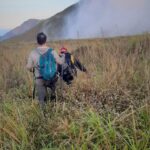- Place a groundsheet or tarp under your tent to create a barrier between you and the ground. This not only provides comfort but also prevents snakes from slithering into your tent.
- Maintain a Well-Sealed Tent:
- Inspect your tent for holes or tears and repair them promptly.
- Keep tent zippers closed when not in use to prevent snakes and insects from entering.
Camping in the wilderness of the Philippines offers an opportunity to connect with nature, but it also brings you face to face with the local wildlife, including snakes. While many of these serpents are harmless, and encounters are rare, it's essential to know how to snake-proof your campsite to ensure a safe and enjoyable outdoor experience. In this article, we'll share valuable tips and precautions to minimize snake encounters and make your camping adventure in the Philippines worry-free.
1. Choose Your Campsite Wisely
- Set your camp at an established campsite. Choosing to camp at an established campsite can be a great way to reduce the risk of snake encounters, as these sites are typically designed with safety in mind.
- If there is no established campsite, look for an area that is away from tall grass, dense underbrush, and rocky crevices, as these are places where snakes may hide.
- Avoid camping near water sources, as snakes may be attracted to them.
2. Clear Your Campsite
- Clear away debris and leaves from your campsite to eliminate potential hiding spots for snakes.
- Ensure that your sleeping area is free from obstacles that may attract snakes.

3. Store Food and Gear Securely
- Store food and trash in airtight containers or bags to avoid attracting snakes and other wildlife.
- Position your food storage away from your sleeping area.
- Keep your gear, including your backpack and clothing, off the ground by hanging them from a tree or using a gear loft if possible.
- Avoid leaving gear on the ground, as it can attract snakes seeking shelter.
4. Exercise Caution Near Rocks, Logs and Dense Bush
- Maintain awareness of your surroundings and watch where you step.
- Make noise while moving around a newly-established campsite to alert snakes to your presence, giving them an opportunity to retreat.
- Be vigilant when moving rocks, logs, or debris, as snakes may be hiding beneath them.
- Use a stick or a tool to flip these objects from a safe distance.
5. Consider Wearing Jeans, Snake Gaters or Boots
- Consider wearing jeans, snake gaiters or snake-resistant boots to provide extra protection for your upper and lower legs and feet.
- These specialized items are designed to reduce the risk of snake bites.

6. Snake-Proof Your Shelter
-
Tent
-
Hammock
- Hang your hammock at a height that is at least waist-level to reduce the likelihood of a snake crawling into it.
- Examine your hammock for any holes, tears, or openings that snakes could enter through. Repair any damage promptly.
- Ensure that your hammock's zippers, if it has them, are closed securely.
- Consider using a hammock bug net or a hammock tent with a built-in bug netting. These accessories not only protect you from insects but also serve as an additional barrier against snakes.
-
Bivy Sack
- Set up your bivy sack on an elevated, flat surface if possible, rather than directly on the ground.
- Regularly inspect your bivy sack for any holes, tears, or openings that snakes could enter through.
- Keep the zippers of your bivy sack closed securely, especially when not in use.
- Consider using a bivy sack with an integrated bug net or a separate bivy tent with bug netting. These features not only protect against insects but also add an extra layer of security against snakes.
-
Forest Huts
- If your mattress or sleeping pad is on or near the floor, install a mosquito net and tuck it in. This will not just protect you from mosquitoes, it will also block a snake from accidentally entering your space.
- Close gaps under and around doors, gates, perimeter fences, and walls.
- Seal holes in walls, including where pipes or cables pass through.
- Trim back vegetation on outer and inner walls to prevent snakes from climbing over.
- Trim branches and other vegetation that allow snakes to climb onto roofs and enter through windows.
- Install screens on open windows and cover slats in doors and windows with mesh.
- Block access through gullies, drains, and pipes to prevent rats and snakes from entering. If necessary, use mesh to allow water to flow.
7. Learn About Local Snakes
- Research and identify the snake species native to the region where you plan to camp.
- Know which snakes are venomous and how to distinguish them from non-venomous species.
8. First Aid and Emergency Preparedness:
- Carry a snakebite kit and basic first aid supplies in case of emergencies.
- If bitten by a snake, seek immediate medical attention and avoid trying to suck out the venom or using a tourniquet.
Remember that snake encounters are relatively rare, and snakes prefer to avoid humans. By taking these precautions and staying vigilant, you can minimize the risk of snake encounters while hiking and camping in the Philippines or any other snake-prone region.








